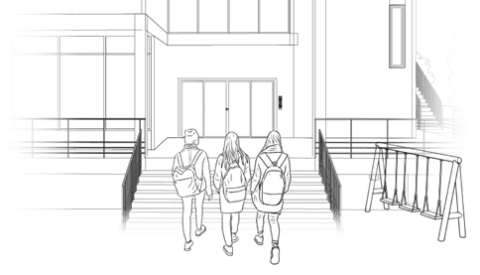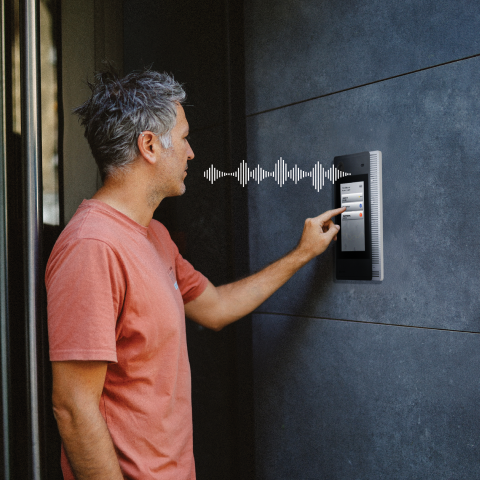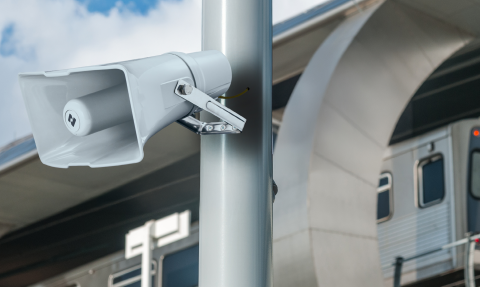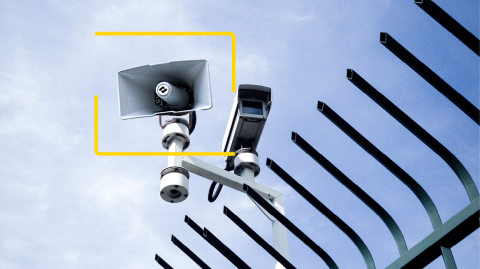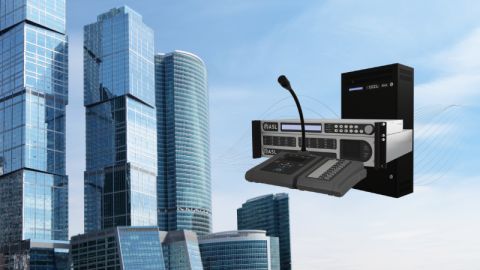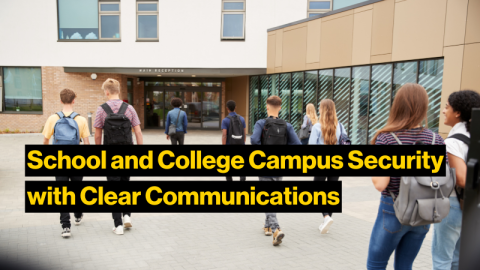School and College Campus Security with Clear Communications
Campus safety and security refers to the measures taken by a school, college or university to ensure the safety of students, staff, and visitors.
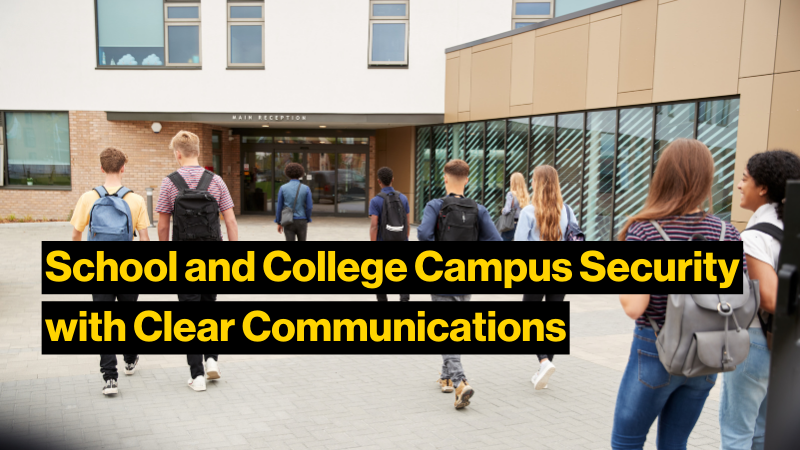
In March of this year, a student and adult were taken into custody after a “physical altercation” led to a nearby high school being placed on campus security lockdown in Cincinnati.
The Woodward Career Technical High School was placed on a temporary lockdown as a precaution after several people got into a fight across the street and attempted to get into the school. The district said its security team followed safety protocols and worked closely with the Cincinnati Police Department during the incident, a news article said.
There was no immediate threat to the campus, and students were soon allowed to resume normal activities. But the incident is illustrative of what could have happened. Most campus environments are not closed or walled fortresses, so incidents like that force security teams to mitigate risks that are in the larger community environment.
When it comes to perimeters, campus security professionals are in an especially complicated position. K12 and college campuses seek to foster a sense of openness while still finding, defending, and managing the perimeter.
Even more, defining a college perimeter can be confusing and challenging, as the college or university expands.
Yet, perimeter security, when done well, can stop or deter crime or malicious activity before it enters onto a premises. It is a solid first line of defense in keeping a K12 or college campus secure.
The Importance of Audio
The security industry is increasingly using clear communications to secure K12 and college campuses. It’s not a surprise, as hearing is key to everything we do as human beings, and sound drives our initial response to every situation, including safety and security.
Clear communications via audio solutions such as IP intercoms and IP speakers can mitigate security risks inside a K12 school and on a college campus. They can also help to secure the perimeter.
For instance, at a K12 school entrance, IP video intercom solutions can identify parents and visitors and help school staff and security teams quickly determine if the individual should enter the school, or not.
At the school’s outer areas, IP public address speakers are easy to install and offer excellent two-way communications, in all conditions. School security teams, using video surveillance, can see an individual trying to enter the school perimeter, and determine, through audio, why they are there or direct them to leave.
Emergency stanchions can provide a visual and audio indicator, to help security teams to identify visitors and vendors outside of a school’s entrances and exit points. They can also be used within school parking lots, far from entrance and exit areas. Once activated by the user, campus security can see and hear who wants access to the school.
At exterior fences and gates, which may still be on school property but a distance away from a school’s entrances, intercom solutions with HD audio can be mounted on the fence to help school security teams to identify individuals, from a distance.
Benefits of Clear Communications
The benefits of audio and clear communications at the perimeter of K12 school or college campus are numerous.
First, it means that a security solution is interactive. Security teams speak to and listen to the person that’s seen on a video surveillance system, via the intercom. A clear voice and sound clarify the intent behind the images that are captured on a camera and increases situational awareness.
Audio can detect voices, noises, or other sounds that are not within direct view of a video camera. Those sounds can be analyzed by a security team and action can be taken before the individual gets to the school doors.
Adding audio also means that a security officer and the person in front of the camera at the intercom, can interact, even when that individual is at outer perimeters, which, if they have ill intent, is where you want them to stay until your security team can arrive on scene. That data, which goes beyond video surveillance images, can be shared between security, police, emergency services, and more. A security team is now providing first responders with actionable data for a more effective response and a strategy to mitigate future incidents.
Yet, it needs to be asked: are all those devices delivering crystal-clear audio? Is the need for users to be clearly heard and understood being met, every time?
Strong, crystal-clear voice communications are possible in any environment, but it requires the right combination of hardware, software, and mechanics.
The Right Hardware
An intercom’s hardware combination of amplifier, speaker and microphone must be robust enough to withstand extreme environments and deliver audio loud enough to overcome all background noise. Any outdoor communication device should incorporate a digital MEMS microphone, allowing audio to be consistently translated into 1’s and 0’s, regardless of extreme temperatures or moisture. A Class-D, 10W amplifier delivers more than 95dB, louder than a semitruck or subway train. And with an amplifier that powerful, a matching 10W speaker is crucial to avoid distortion at high volumes.
The Right Software
With IP technology, audio processing software can be deployed directly in the edge device to create the best intelligibility. Noise Reduction technology removes background noise so that the operator can clearly hear the caller. Native, Onboard Acoustic Echo Cancellation prevents feedback and enables full Open Duplex communication, where both people can talk at the same time, and be understood. Devices should also intelligently adjust to the environment – Automatic Gain Control will take a voice that is too loud or too weak and level it out to an undistorted and clear signal. Automatic Volume Control will raise the speaker volume, so it is always loud enough to be heard.
The Right Mechanics
The mechanics of an intercom are important, as well. A traditional, vandal-resistant intercom speaker design uses two overlapping stainless-steel plates, which trap the sound waves between them and create distortion, especially at higher volumes. Instead, the speaker grill should incorporate an anechoic, circular design where there’s no reflection of sound waves as they pass through the station’s faceplate. The result is crystal-clear audio, even at the loudest volume. Unfortunately, loud volume creates significant vibration, so the speaker grill should be die-cast into a rigid aluminum frame and the microphone surrounded by a dampening material, to protect against the transfer of any sound vibrations. All these mechanical elements work together to produce strong, distortion-free, intelligible voice audio.
Only this combination of hardware, software, and mechanics will ensure clear audio and clear communications. When you understand how intelligible audio is achieved, then you can find the communications solution that will reliably allow you to hear, be heard, and be understood, every time.
Every K-12 school and college school security team faces increasingly complex threat environments, especially at their perimeters. Audio solutions via intercoms and IP speakers are the solution to providing intelligence and communications and to securing those perimeters.
Yet, the importance of high-quality, clear audio cannot be understated. It is useless to purchase a communications system if the audible announcements and messages can’t be heard or understood, every time and everywhere. Take the time to find communication solutions that enable everyone to hear, be heard and be understood, every time and everywhere.
Learn more about Zenitel's solutions for education here: https://www.zenitel.com/education-communication-solutions
This article originally appeared in the April 2024 issue of Security Journal Americas:
https://securityjournalamericas.com/






